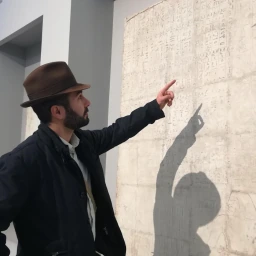The civita of Alatri stood on the slope of a hill above a stream, a branch of the Liri river. There, five hundred metres above the sea level, was the acropolis of the ancient city. Still visible are the quadrangular base of a small temple in Tuscan order, a reconstruction of which is now in the National Etruscan Museum housed in the Villa Giulia in Rome, and the imposing megalithic walls.

The megalithic walls of Alatri
That cities have had defensive walls since antiquity is a well-known fact, but in Alatri the construction work is more than a little enigmatic. First of all, the entire perimeter is well preserved for all of its approximately four kilometres. This is a historically exceptional event, which makes the walls of Alatri the best preserved of all the megalithic architectures in Lazio. Even more extraordinary is the trapezoidal geometric shape of the wall. Made of polygonal work, its gigantic and irregular blocks fit together perfectly, reaching a height of fifteen metres in some places. This is why the walls were called ”cyclopean” since ancient times, as if those mythical giants had built them. Hence, the huge blocks of limestone make the construction megalithic, according to the original and literal Greek etymology of the term.

A polygonal opus
The polygonal opus was a widespread architectural technique in central Italy from the 7th century B.C. onwards, but it is also found in a variety of periods and contexts. Its predominant characteristic is the absence of binders between the overlapping boulders, such as mortar. The use of this this dry stone method depended on the considerable weight of the stones used, which guaranteed sufficient stability even for works of considerable height, as in Alatri. The stability of the wall construction was then guaranteed by the juxtaposition of larger boulders along the foundations, and smaller blocks on top.

A classification of polygonal work is due to the archaeologist Giuseppe Lugli, whose studies contributed to the knowledge of the Latius Vetus area. Lugli proposed four construction types depending on the overlapping characteristics of the boulders and their workmanship1. In the first and second manner, the blocks appear little or not at all smoothed, and are stacked without and with the use of interstitial filling stones respectively. The third manner, to which Alatri work belongs, is characterised by the use of polygonal, smoothed and perfectly interlocked geometric stones. Finally, the fourth manner involves the use of quadrangular blocks.

The problem of dating the megalithic walls in Alatri
With regard to the study of the walls at Alatri, the greatest difficulty lies in determining a reliable date. This is a long-standing question that concerns many scholars and, more generally, most megalithic constructions in Lazio. Even today, there is still no unanimous opinion among archaeologists.

In the 19th century, Petit-Radel hypothesised that the polygonal work had been spread spread by the pre-Hellenic Pelasgian peoples since the 16th century B.C.2, an assumption later proven to be unfounded. Nevertheless, the merit of the French archaeologist was to draw attention to the enigma of the megalithic works. In the 20th century, Luigi Pigorini and especially Filippo Coarelli3 proposed a systematic study of the phenomenon. Thanks to their documental and stratigraphic research, the dichotomy between Roman or pre-Roman dating of the polygonal work was overcome.


Alatri and the polygonal opus through the centuries
Today, albeit with a considerable temporal uncertainty, it is certain that the megalithic walls of Latium were built both by the Italic peoples of Latium, such as the Hernici, Volsci and Aurunci, and later by the Romans. In particular, it was suggested that the Hernici were the authors of the lesser polygonal work (1st and 2nd manner), perhaps in the protohistoric age. According to Coarelli the evolution of the technique (3rd manner) is due to the interaction with Greek craftsmen (6th century B.C.), who revived the ancient Pelasgian methods. Finally, the fourth manner of the polygonal opus is similar to the Roman opus quadratum, with the only difference being the material used: limestone instead of tufa. Therefore, it could be of Roman origin.
The walls of Alatri are traditionally attributed to the Hernici, considering the time framework and historical context. The most commonly proposed date is the 4th century B.C. for the polygonal work5. However, such a monumental and architecturally complex work probably took a long time to be completed. In fact, we can see a difference between the layers of the blocks and the stones placed higher were probably added during the Roman period.
Samuele Corrente Naso
Notes
- G. Lugli, La tecnica edilizia romana con particolare riguardo a Roma e Lazio, Roma, 1957. ↩︎
- L. C. François Petit-Radel, Recherches sur les Monuments Cyclopéens ou Pelasgiques, 1841. ↩︎
- F. Coarelli, Lazio, Laterza, Bari, 1982. ↩︎
- A. Frusone e G. Zomparelli, Alatri, tipografia Strambi, 1986. ↩︎
- Ibidem note 3. ↩︎


